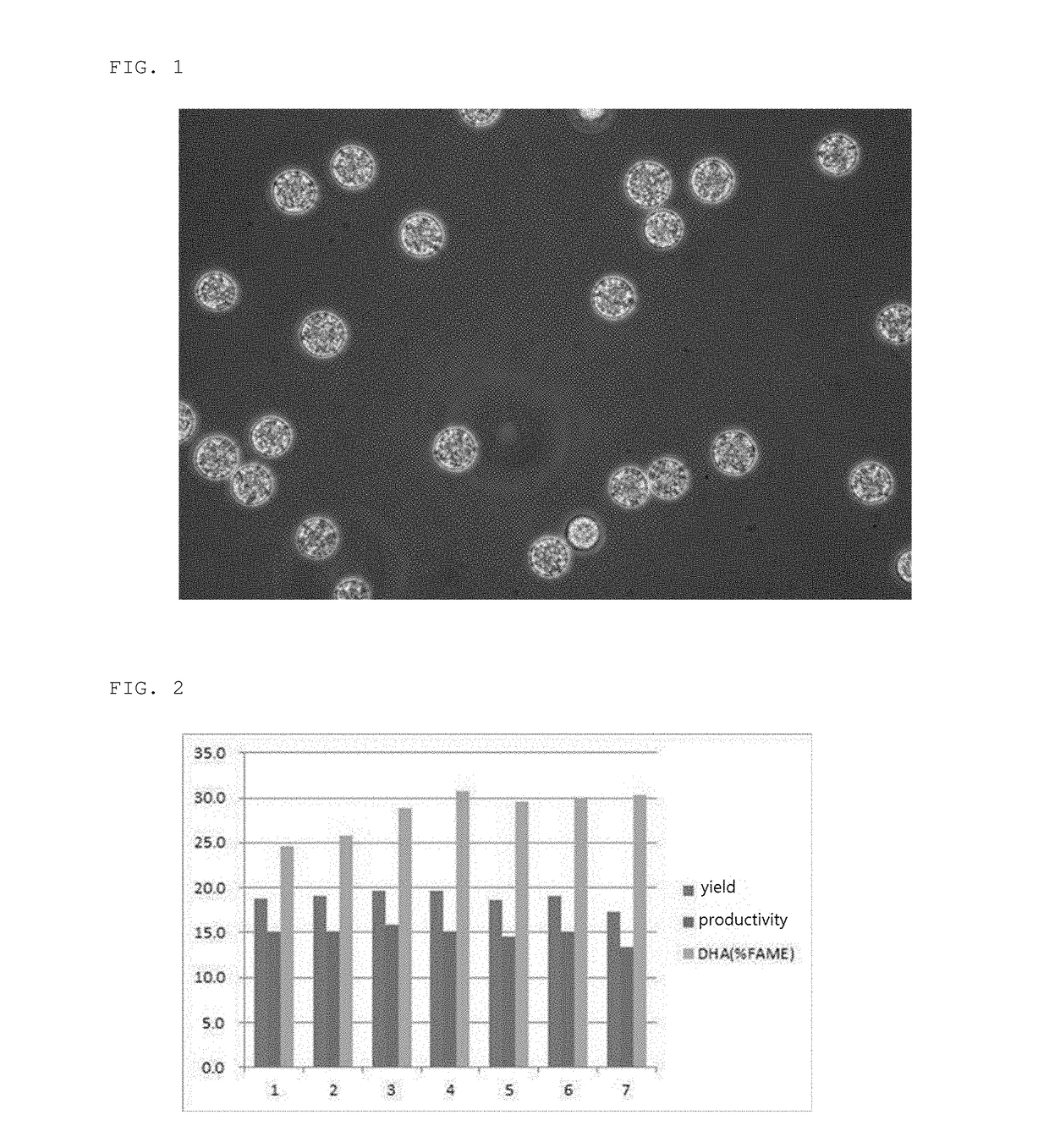Microalgae aurantiochytrium sp. LA3 (KCTC12685BP) and method for preparing bio-oil using the same
a technology of microalgae and thraustochytrium, which is applied in the field of microalgae of thraustochytrium and a method for preparing biooil using the same, can solve the problems of pollution, difficulty in ingesting fatty acids mainly through food, and not very much appetite, so as to improve the efficiency of a culture process and high unsaturated fatty acid productivity
- Summary
- Abstract
- Description
- Claims
- Application Information
AI Technical Summary
Benefits of technology
Problems solved by technology
Method used
Image
Examples
example 1
n of Microalgae
[0048]In order to screen microalgae having excellent bio-oil producibility, microalgae of a Thraustochytrid family were separated from floating matters in a coastal wetland or a hot springs area wetland, in the following manner.
[0049]A sample of floating matters was added to 50 mL of a medium containing 10 g / L of glucose, 2 g / L of yeast extract, 2 g / L of peptone, 1 g / L of KH2PO4, and 30 g / L of sea salt, and cultured for a day. 50 mL of the obtained culture fluid was smeared on a solid medium containing 10 g / L of glucose, 2 g / L of yeast extract, 2 g / L of peptone, 1 g / L of KH2PO4, 30 g / L of sea salt and 15 g / L of agar, and thereafter, cultured at 28° C. for 5 days to obtain seven colonies, and the obtained seven colonies were subcultured 4 times to be purely separated.
[0050]Each of the colonies was cultured in a 50 mL shaking incubator at 28° C. for 4 days at 150 rpm using 5 mL of a liquid medium (glucose 60 g / L, corn steep liquor 14.4 g / L, sea salt 10 g / L, potassium ph...
example 2
ation Through 18S DNA Analysis
[0052]For molecular biological identification of the finally screened strain #4, a 18S rRNA gene sequence was analyzed. After chromosomal DNA was separated from one colony, 18S rRNA gene DNA was amplified by a PCR method, using primers for amplification of a 18S rRNA gene of microalgae of a Thraustochytrid family, F: 5′-AACCTGGTTGATCCTGCCAG-3′ (SEQ ID NO: 2) and R: 5′-TTGTTACGACGACTTCACCTTCCT-3′ (SEQ ID NO: 3). After removing a salt, an amplified reaction solution was analyzed by Macrogen Corporation for a base sequence, and the sequence was identified as SEQ ID NO: 1. As a result of search through NCBI (National Center for Biotechnology Information) Blast, the screened strain was found to be novel microalgae of a Thraustochytrium, and deposited in a gene bank of Korean Collection for Type Cultures as Aurantiochytrium sp. LA3 (KCTC12685BP) on Sep. 26, 2014.
Example 3. Analysis of Growth and Bio-Oil Production Characteristics of Aurantiochytrium sp. LA3 (...
PUM
| Property | Measurement | Unit |
|---|---|---|
| wt % | aaaaa | aaaaa |
| energy intake | aaaaa | aaaaa |
| pore size | aaaaa | aaaaa |
Abstract
Description
Claims
Application Information
 Login to View More
Login to View More - R&D
- Intellectual Property
- Life Sciences
- Materials
- Tech Scout
- Unparalleled Data Quality
- Higher Quality Content
- 60% Fewer Hallucinations
Browse by: Latest US Patents, China's latest patents, Technical Efficacy Thesaurus, Application Domain, Technology Topic, Popular Technical Reports.
© 2025 PatSnap. All rights reserved.Legal|Privacy policy|Modern Slavery Act Transparency Statement|Sitemap|About US| Contact US: help@patsnap.com

